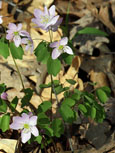 The delicate flowers of rue anemone are held in clusters of three to five flowers with the center flower being larger than the lateral ones. They are borne on slender stems so they blow easily in the wind giving movement to the deciduous forest floor where they are found in the wild. The leaves are particularly attractive and interesting; they have three lobes resembling mittens and are borne as a basal tuft as well as on short stems in whorls on the flower bearing stems. The plant dies back after flowering and goes dormant until the next spring.
The delicate flowers of rue anemone are held in clusters of three to five flowers with the center flower being larger than the lateral ones. They are borne on slender stems so they blow easily in the wind giving movement to the deciduous forest floor where they are found in the wild. The leaves are particularly attractive and interesting; they have three lobes resembling mittens and are borne as a basal tuft as well as on short stems in whorls on the flower bearing stems. The plant dies back after flowering and goes dormant until the next spring.
Type: Herbaceous perennial.
Bloom: Pale pink to white 1” blossoms in early spring.
Size: 4-8” H x 6-12” spread.
Light: Part shade in spring; shade in summer.
Soil: Humus rich, moist but well drained, with pH of 6.8.
Hardiness: Zones 4-8.
Care: Low maintenance.
Pests and Diseases: Susceptible to powdery mildew, rust, smut and slugs.
Propagation: Root cuttings, division, or seed. Spreads by reseeding.
Companion plants: Trout lily, Spring Beauty, Jack in the Pulpit, Trilliums, ferns and other woodland species. The ferns are particularly good companions as they will hide the space left by the rue anemones when the go dormant in spring.
Comments: All parts are toxic if eaten fresh and in large quantities.

I was so excited to see my rue anemone this spring! I found it at a plant rescue last spring and planted it, but I thought it died.
Jackie,
Lucky you! I don’t have enough shade in my present garden to try woodland plants. Maybe soon…
Karen